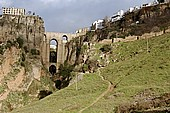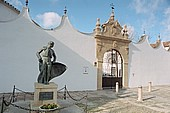Rising amid a ring of mountains is the Andalucian town of Ronda. A Celtic village, the Roman "Laurus" and the Arabs rich provincial capital named "Hisn-Rand-Onda", much of Ronda attraction lies in its spectacular views. Built on an isolated ridge of the sierra Ronda is split in two sections by a deep gorge of the river Tajo with a sheer drop of 130m on three sides while tall whitewashed houses lean from its precipitous edges. The gorge is spanned by the stupendous 18th C New Bridge (Puente Nuevo).
On one side of the bridge is the old medieval Moorish town, called La Ciudad on the other side is the more recent urban development called El Mercadillo.
The Ciudad retains intact its Moorish layout and the Renaissance mansions of the old nobility with lots of grilles, balcony's and windows' ironwork characteristics of the region.
Ronda, Puente Nuevo
|
 |
Main monuments are: House of Juan Bosco. Casa de Mondragon at the edge of the cliff and organised around three beautiful courtyard a and a lovely garden with views over the valley. The gothic church of
Santa Maria la Mayor with the arch of Mirhab left from the former mosque and horseshoe arches of the “Casa del Sacristán” (sexton's house). In the main square we can see the nearby nice
town hall. The minaret of St. Sebastian formerly a small tower belonging to one of the mosques of Ronda. From Plaza del Campillo there is a winding walkway to the Cristo Arch with very nice view over the new bridge.
Casa del Rey Moro (House of the Moorish Kings), from its garden a remarkable 365 steps underground stairway called the "Mina" descends to the river.
Palacio de Salvatierra with a magnificent baroque façade. From here there is a walkway that pass the
Arch of Philip V, with three pinnacles at its top, and across the Puente Viejo (16th century), the small Arab bridge, (11th century) reaches the very well preserved Arab baths (13th and 14th.century). From this point you can make a very interesting walk rounding the Ronda Arab walls. At the Arab age the Medina had well defined limits: on one side the gorge on the other side the city walls that are well conserved today. We first go through the Islamic defensive line by the gates of Cijara, the entrance to the Arab Medina, we pass by the Gothic church of the Holy Spirit and we reach the impressive
Almocabar gate (from the Arab word “Al-maqabir“, that means cemetery) at the southern end of the old town.
 |
Ronda, the Bullring
|
The Mercadillo quarter grew up in the wake of the Christian conquest and it is of comparatively little interest. The popular
Plaza de España. The famous Bullring, one of the earliest in Spain, the birthplace of the modern Corrida, constructed in the year 1785 in Neoclassical style with a Baroque doorway it is the sanctuary of bull-fighting on foot. The beautiful cliff top "paseo" (walkway) from where excellent views of the new bridge can be glimpsed. Start the walk at the Alameda Gardens near the
Mercedes Convent, from here you can walk towards the bridge passing along the best panoramic views over the mountains.
|
|
|



